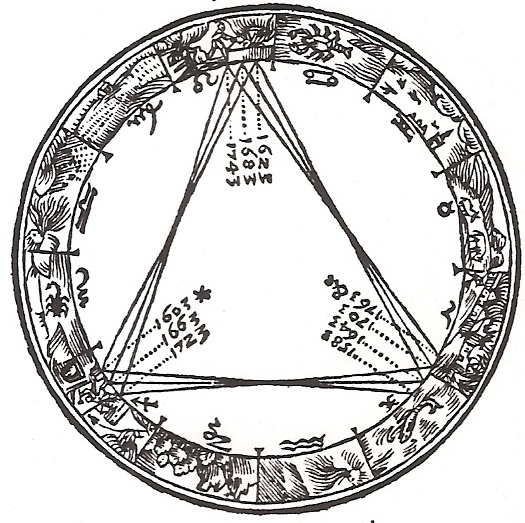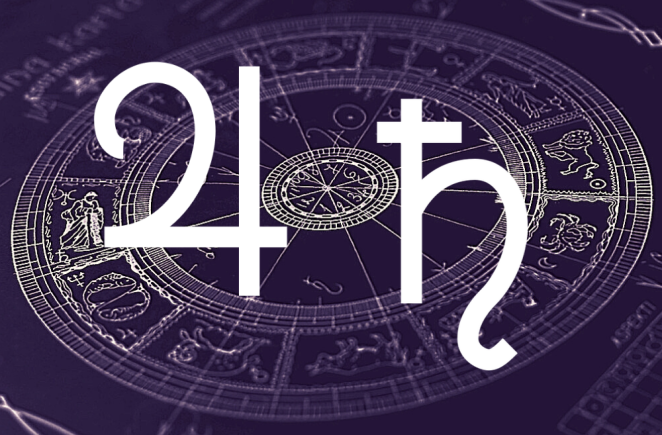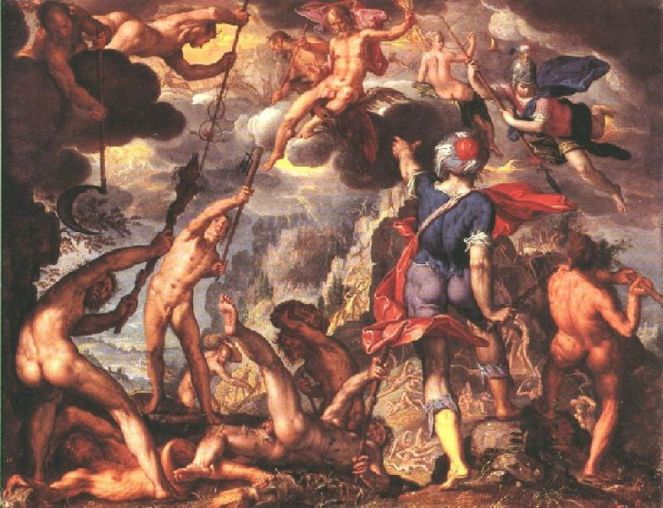The much anticipated Jupiter Saturn conjunction finally arrives on 21 December 2020 in Aquarius. This marks the end of a 20 year cycle and the start of a new one. But it’s also the start of a 200 year cycle of conjunctions in air signs. In this post, we’ll explore how that cycle works and what it means…
The Jupiter Saturn conjunction is called the Great Conjunction and it happens roughly every 20 years in the same element, or triplicity. Each conjunction takes place slightly later and progresses forward over 200 years until they shift into the next triplicity. This forms a pattern of repeating triangles, as drawn by Kepler in his De Stella Nova:

When the conjunctions shift into a new element this is called the Great Mutation and it marks the end of one era and the start of a new one, each lasting roughly 200 years. The Mutations follow the elements around the zodiac, shifting from fire to earth to air to water, in a continuous cycle.
It takes 800 years to move through all four elements, and 2,400 years to move through the entire zodiac and return to the start (3 x 800). So the whole cycle is really a set of interlocking cycles, each inside the other, lasting 20 years, 200 years, 800 years, and 2,400 years.
We’re now coming to the end of a 20 year cycle that started with the conjunction in Taurus in 2000, and the end of the 200 year earth cycle which started in the 19th century. We’re moving into a new cycle of air conjunctions but this process isn’t a simple shift.
There are two ways to calculate the Great Mutation based on the true conjunction and the mean conjunction. The true conjunction is when we can see the planets align in the sky. The mean conjunction is a mathematical average that happens at regular intervals based on the planet’s average cycle lengths. There’s more to it than this and you can read more here: Understanding the mean conjunction of the Jupiter Saturn cycle
The mean conjunction dates are different to the true conjunctions. This year the mean conjunction in Aquarius was on 14 September, while the true conjunction will be on 21 December. However, according to the mean conjunctions, the shift into air happened with the conjunction in Gemini on 4 November 2000. The true conjunction that year was in Taurus.
So when does the Great Mutation happen? With the mean or true conjunction?
It’s best not to see this shift as starting on the nose on a particular date or with a particular conjunction. It works better when you see them as cycles fading in and out.
Perhaps the mean conjunction, being a mathematical ideal, is like a morphic field of the change that’s about to happen. It’s not grounded in reality yet because we can’t see it. When we get the true conjunction – we can see it in the sky – then it becomes real for us.
Looked at this way, the last 20 years could be seen as a transition into the new air era. But – of course – it’s not as simple as that! There’s another way to look at this using just the true conjunctions.
With the true conjunctions, the cycles overlap and toggle back and forth between the elements. For example, the run of earth conjunctions was broken in 1980-81 with three conjunctions in air sign Libra. This was followed by the final earth sign conjunction in Taurus. So the coming Aquarius conjunction marks a final definite shift into air.
From this perspective, the period between the Taurus conjunction in 2000 and the Aquarius conjunction in 2020 is the transition between eras. But you could also argue for a 40 year transition starting in 1980 – and events certainly support that view.

With all that in mind, here’s a rough guide to the element cycle dates, starting with the previous earth cycle (specific dates in brackets):
- Earth cycle: 11th and 12th centuries (1007 – 1206)
- Air cycle: 13th and 14th centuries (1186 – 1405)
- Water cycle: 15th and 16th centuries (1365 – 1643)
- Fire cycle: 17th and 18th centuries (1603 – 1821)
- Earth cycle: 19th and 20th centuries (1802 – 2000)
- Air cycle: 21st and 22nd centuries (1980 – 2199)
The specific dates are messy and some of the overlaps are longer and more complicated than others. For example, the previous earth era ended with the same 40 year sequence as the current cycle:
- Libra conjunction in 1186
- Taurus conjunction in 1206
- Aquarius conjunction in 1226
But the transition out of that era into the water cycle was longer. It started in 1365 with a conjunction in Scorpio, but then there were two more air conjunctions, one in Gemini in 1385, and another in Aquarius in 1405. The cycle finally shifted into water with a conjunction in Scorpio in 1425. That’s a 60 year transition.
For the sake of completeness, the current earth cycle started in 1802 with a conjunction in Virgo, followed by the final fire conjunction in Aries in 1821. It finally landed in the earth cycle with a conjunction in Capricorn in 1842. The 40 year transition out of earth started in 1980, and from December we’ll be in the air cycle until 2199.
You can see tables of the true conjunctions going back thousands of years on Richard Nolle’s site here.

Jupiter Saturn alignments correlate with major turning points in the structure of societies and civilisations. This is true on the small 20 year scale, as well as the longer 200 year cycle. The Great Mutation often coincides with a major shift in political and social organisation, indicating the rise and fall of empires, the deaths and/or rise of kings, queens, and leaders, and new systems of government and control.
For example, Kepler believed the Star of Bethlehem that guided the Magi to the birthplace of Jesus was the Jupiter Saturn conjunction that happened in 7 BCE in Pisces. The conjunction occurred three times that year, in May, October, and December. In her book Jung and Astrology, Maggie Hyde explains the symbolism:
“Jupiter symbolises Christ as ‘King of the Jews’ because of its association with kingship, dominion and religious teachings. It was dignified in its own sign of Pisces and Palestine was traditionally believed to be governed by that sign. Saturn had always been associated with the Israelites and the Jewish Sabbath is still Saturday, Saturn’s-day.”
These conjunctions marked the end of an 800 year cycle through the elements – seen as a big deal because they were also in Pisces, the final zodiac sign. They were also the final conjunctions in the water cycle that started in 225 BCE, as it was beginning to shift into fire.
Birth of kings aside, Great Mutations correlate with changes to belief systems and the ideas that underpin society as reflected in the element in which the conjunctions occur. For example, the earth cycle corresponded with a massive consolidation of empire building and mastery of the material world in the Industrial Revolution. But these developments didn’t arise out of nowhere.
The events of one cycle seed developments in the next, with changes building over time. However, the movement between cycles isn’t necessarily progressive. As with all things in life, some things improve while others don’t. Mostly, it’s just complicated. 😉
We’ll explore the historical developments of the element cycle in the next post, but first a look at the archetypes involved in this alignment:
The Jupiter Archetype
The Jupiter archetype represents the desire for meaning and growth and includes our experience of optimism, faith and confidence in life. It’s associated with beliefs, philosophy, education, ideals and visions of the future. As well as the legal system and social rules that hold society together.
Jupiter energy is expansive, inspiring, and future-oriented, bringing luck, knowledge, abundance and grace. But also greed, arrogance, inflation, and waste. As the ‘Great Benefic’ it encourages us to connect with something greater than ourselves and expand our horizons, both inner and outer.
Jupiter is linked to Zeus, the Olympian who overthrew his father, Kronos, to become King of the Gods. For more read: Jupiter Keywords, and Jupiter Myths
The Saturn Archetype
The Saturn archetype represents the reality principle and includes our experience of restriction, limitation, structure, boundaries, and time. It’s associated with security and stability, organisation, control, judgement and the law. As well as authority, responsibility, wisdom, tradition, old age, and death.
Saturn energy is slow, heavy and dense, bringing repression, defeat, failure and endings. But also increased patience, effort, endurance, and concentration. As the Lord of Karma, Saturn also represents necessity, harvest, and reaping what you sow.
Saturn is linked to Kronos, the Titan who castrated Ouranos, and then swallowed his own children. For more read: Saturn Keywords, and Saturn Myths

These two planets rule the final four signs of the zodiac – Sagittarius to Pisces – so they’re both associated with the collective of humanity and the laws that govern society. Although they represent opposite archetypes, they work to balance each other out. Jupiter expands and provides Saturn with visions of a greater future, while Saturn grounds Jupiter and provides a reality check to optimism and ideals.
This means the 20 year cycle tends to swing between periods of expansion and contraction divided into smaller half-cycles of about 10 years driven by the conjunction followed by the opposition. Events will tend to rise and expand from the conjunction and then fall or unravel from the opposition. In New Insights in Modern Astrology Stephen Arroyo explains:
“The first ten years of a cycle are more intense, and there is a sort of winding up leading to the peak of the Jupiter Saturn opposition. The last ten years of the cycle often seem to be a winding down of the intensity, pace, and overall direction that was present in the earlier stages of the full cycle.”
This effects both individuals and societies, so:
“During the first ten years, people tend more to initiate, project, experiment, and many rapid changes happen, as well as most of the biggest crises. Then, during the second ten years, people often seem to be exhausted, needing a period of reflection and assimilation since the pace of change has been too rapid to sustain.”
Basically, what goes up must come down. He goes on:
“…the first ten years mark a decided extroversion, optimism in many cases, or at least striving for an ideal or fighting for a cause. As the opposition approaches, the intensity of extroversion and the level of outward-directed confidence begins to wane, both nationally, socially, and in many cases individually.”
The pattern between expansion and contraction isn’t precise, but you can see a general trend in many decades: growth in the 1920s following the conjunction in 1921, followed by depression in the 1930s after the opposition, for example.
We can’t be too simplistic about this because one person’s expansion often means another person’s contraction. Reality looks quite different from opposite ends of a hierarchical structure. And Jupiterian expansion, or growth, can apply to negative things as well as positive ones.
For example, after the Libra conjunctions in 1980-81 the deregulation of the financial markets and the belief in neoliberalism created enormous growth in some parts of the economy. But it was fuelled by debt and relied on mass unemployment – a growth in poverty. There are communities that still haven’t recovered, especially in the industrial heartlands.
The massive bubble of 80s excess imploded in the 90s into a recession and the call went out for greater fairness in society. But another bubble was inflated after the conjunction in Taurus in 2000 with the selling of dodgy real estate. That bubble burst in 2008 with the credit crunch, shortly before the 2010-11 Jupiter Saturn opposition, introducing a decade of austerity.
(There were other alignments in play for that event, such as the Saturn Pluto square and Saturn Uranus opposition. It’s all interconnected so you can never look at one cycle in isolation.)
So here we are on the brink of another conjunction wondering what’s going to happen next. To find out we need to go back in time to explore the history of these cycles in more detail. In the next post we’ll discover what happened last time we transitioned out of earth into an air cycle…
Images: Trigon; Cycle; Fisticuffs
More Jupiter Saturn Cycle posts
Thanks for reading! To support my work, donate below 🍵. Thanks in advance! 🙏❤️


excellent post, I’m coming back to this as we build up to the opening square of this cycle next year!
LikeLiked by 1 person
Thanks for tthis blog post
LikeLike
hi Jessica just to let you know that I’ve linked to this feature in my weekly blog – https://joannawatters.com/no-ordinary-winter-solstice-the-voice-of-aquarius-why-astrology-helps/
with thanks, really helpful for my readers, Joanna
LikeLiked by 1 person
Thank you for all your hard work, time, and dedication to helping us all learn from you. God bless!!
LikeLiked by 1 person
You’re welcome, Adrian!
LikeLike
Excellent, informative article. As an astrologer myself I couldn’t have put it better! Well done.
LikeLiked by 1 person